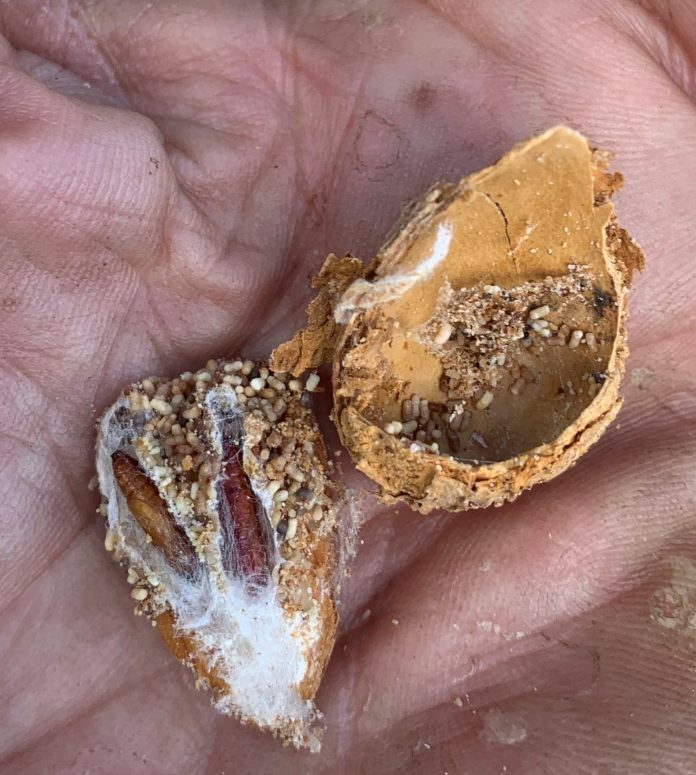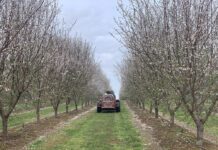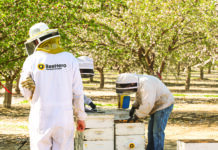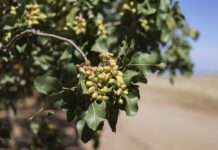With winter upon us, here are a few things to keep in mind going into next season.
Irrigation
Check out/maintain your system. Information on maintaining the system is available in the notes at the end of the column. In the Sacramento Valley, there are two mobile irrigation labs that offer irrigation system evaluation services.
Now is also a good time to look back on the irrigation year. Anything you liked/didn’t like with your system(s)? What can you add/consider that improves irrigation, which improves orchard health, which should improve yield and returns?
For example, last summer we tried out an irrigation monitoring device implanted in the trunk of an almond tree and connected to the internet through a sim card. Output from this device closely mimics pressure chamber values in UC research. It also tracks water pressure in the irrigation system so irrigation set timing and tree water status can be compared. After testing this one device in one tree for a year, I’m more comfortable expanding use of this technology while maintaining spot checking with a pressure chamber. I recognize we are in very tough times, but finding small (or large) ways to improve important practices now should help in the long run and, at least for me, help think toward a positive future despite our current reality.
Pests
Navel orangeworm (NOW) damage was terrible in many regions of the state this past year. Damage was especially bad in the areas of the Sacramento Valley hard hit by the Feb. 24, 2022 freeze. Crop and income loss in those areas made sanitation difficult to afford last winter. Add in the general economics of both almond and walnut growing, and sanitation suffered. The resulting bump-up in the 2023 NOW population in many districts tested all parts of NOW IPM, including spray practices, harvest timing, etc.
What can be done going into 2024 to help deliver a cleaner crop?
First step is to sanitize, sanitize, sanitize. NOW has multiple generations per year, and the numbers build with every generation. The lower the starting population, the lower the pressure when the crop becomes vulnerable in the summer.
So, right now, reduce the overwintering population and remove habitat for the spring generation. Sanitize as completely and as carefully as possible. All the varieties. All tree nut crops. NOW can overwinter between the hull and shell in almonds, so hard shell varieties need to be cleaned up too. The lower the remaining mummy count in the spring, the lower the NOW pressure in your orchard as the season starts. That’s the basic starting point for a NOW IPM program for the year.
Careful sanitation is needed, so it’s good to review the overall practice. Sanitation is a three-step process: Knock the mummies out of the trees by roughly February 1, gather in windrows and grind/shred up with a flail mower by March 1. Each step is reducing NOW survival somewhat, but the complete program (shake, sweep, destroy by shred or disc) should be done to make the investment really pay off (see Table 1) for NOW moth survival following different sanitation steps). The final step (shredding by flail mower) in almond and walnut orchards must be done carefully. Tractor speed should be slow enough that all mummies are destroyed. If the tractor moves too fast, all the mummies may not be crushed and some NOW survive. In pistachio orchards, discing mummies reduced NOW survival compared to mowing in research trials.
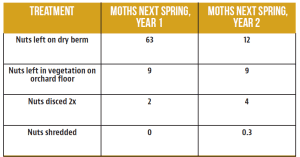
The goal of orchard sanitization is to reduce the number of mummies in the orchard to levels established by careful research. The lower the number of mummies in the orchard, the lower the population in the spring. Each mummy in the trees or on the ground can house/host multiple NOW. Five to seven NOW larvae in a single almond mummy nut were common in a UC trial several years ago. One mummy contained 12 worms.
UC IPM’s almond orchard sanitation standards appear in Table 2. These are the number of mummies to be found in 20 trees per orchard as of February 1 to reduce NOW populations to the point where other practices (mating disruption, pesticide sprays and timely harvest) can reduce NOW damage to acceptable levels. “Gold” and “Platinum” standards are not part of the UC IPM guidelines, but I use these terms to point out while both are good, one is a level up from the other.

NOW are strong flyers, and “dirty” orchards can be sources of invading NOW into carefully sanitized orchards at hull split. Wherever possible, work with your neighbors to reduce NOW populations in the region by sanitizing all orchards and removing wild volunteer almonds in right of ways and other locations. The fewer mummies in your neighborhood, the cleaner your crop (and your neighbors) can be next harvest.
While NOW sanitation is the No. 1 task this winter, there are other practices to consider. Check dormant spurs for scale, especially San Jose scale. Most growers will probably not have to spray for scale, but this stationary pest can “creep up” on growers, and occasionally an orchard will need treatment. Scale inject toxin into wood. If ignored, large scale populations can kill scaffolds. Also check dormant canopies for scab lesions. If pressure is strong enough, an oil and chlorothalonil (Bravo®, etc.) or copper spray can delay sporulation and possibly avoid a spring spray (if no rainfall at the later sporulation timing). Check with your PCA regarding monitoring, treatment thresholds and materials. If a dormant spray is needed, be careful with dormant spray timings and practices to avoid spray drift off the orchard. Faster ground and slower fan speeds can be used to get the job done efficiently, effectively and reduce drift.
Talk with your PCA about options for weed control, especially considering the forecast of a wet El Niño winter. Preemergent herbicides can provide longer control than repeated use of postemergent “burndown” materials. Sequential applications of preemergent herbicides using lower label rates can provide longer control than one single spray at a high rate. See the article on sequential pendimethalin applications for control of glyphosate-resistant summer grass (jungle rice) in the notes.
Preemergent herbicide use can also improve weed control and rodent management in young orchards in wet springs. Vole damage in young orchards can spike up in wet winters/springs due to difficulties getting into orchards to maintain weed control with postemergent herbicide sprays (the best approach to vole control is keeping the tree rows clean so hawks and owls can see the rodents and control them.) Consider a preemergent program this winter to maintain good weed control through at least the spring in a young orchard. Talk with your PCAs about label requirements and orchard age to set up a safe and effective preemergent program in young orchards.
For all preemergent applications, make sure to blow leaves off the soil where the spray will go to allow direct application to the soil, not onto leaves. This will provide the best weed control possible.
Finally, gopher management in the winter before breeding spikes the population should be on the radar. With practice, a fresh mound system can be probed and trapped or baited very quickly. Keep the tools handy.
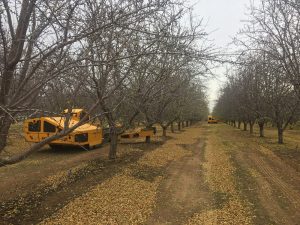
Nutrition
Nutrient use is basically zero in dormant trees. Soil-mobile nutrients should not be applied now as winter rains will leach the nutrients out of the rootzone before leaf-out and the start of tree nutrient uptake. On the other hand, nutrients with relatively low soil mobility, particularly potassium (K), can be applied in the winter without fear of significant loss. In sandy soils, some potassium can be leached, so a lower rate may be applied, and the remainder delivered in the spring via fertigation.
A fall maintenance application of 175 to 200 lbs K2O per acre, banded on the soil, is the traditional orchard potassium recommendation and is still valid in almonds (recent UC research indicates annual crop K use is roughly 90 lb K2O per 1000 pounds of kernel crop, so higher rates may be justified to replace crop K use in highly productive orchards.) If banding dry K fertilizer in a drip-irrigated orchard, place the fertilizer band where irrigation water will reach next summer. Work in walnuts orchards in the 1990s showed that K levels were similar whether the fertilizer was placed on both sides of the tree row or just one, cutting application drive time in half. Local broadcasting of dry K fertilizer in the tree row is now common in microsprinkler irrigated orchards.
With uncertain bloom weather and relatively high cost of K fertilizer, growers may want to wait to assess tree nut set next spring before starting a K fertigation program tailored to feed the crop in the orchard. Ultrafine SOP is the most cost-effective K fertilizer material to my knowledge, but using it requires a solution machine and labor to feed it. Liquid K fertilizers such as potassium thiosulfate (KTS) and potassium carbonate (potcarb) are convenient, effective and relatively high in K content (24% to 30% K2O by weight). In addition, these liquid materials serve as soil amendments, lowering (KTS) or raising (potcarb) soil pH (fertilizer rates and soil texture determine just how much the pH changes.) Some growers split K fertilization between fall banding and in-season fertigation.
Growers have many choices in K fertilizer materials and timings. The main objective is to keep July leaf K levels at least at 1.4% K. Given current almond economics, light K input and monthly leaf K analysis (April, May, June) ahead of July sampling should give growers and CCAs working with them the needed information to avoid yield losses that follow deficiency. Current UC research is examining potassium application practices.
Walnuts
Many of the same practices listed above for almonds apply to walnuts. Sanitizing orchards by shaking, sweeping and mowing/shredding old nuts is also an important in walnut production. As in almonds, completing the job by shredding the nuts on the ground is critical to reducing NOW populations to the lowest level possible. See a link to the research article on this topic in the notes.
Monitor for walnut and San Jose scale this winter and, where needed, plant to treat orchards in the delayed dormant. Unlike almonds, oil use in walnuts should be approached with caution. Check the label and consult your PCA regarding oil with IGRs (Centaur, Seize, etc.) for scale control. Controlling scale can be an important part of Botryosphaeria management.
Check the July leaf analysis results from last summer and consider applying dry potassium fertilizer this winter if needed. Talk with your PCA about rates and materials. Walnuts are much more sensitive to chloride than almonds, so be cautious when considering using MOP (muriate of potash, potassium chloride) in walnut orchards.
See the discussion of preemergent herbicides earlier in this column. Many of the strategies listed there apply to walnuts, but talk with a licensed PCA regarding materials and rates.
Happy Holidays to all.
Links to FREE Resources
Mobile irrigation labs:
North Sacramento Valley: tehamacountyrcd.org/mobile-irrigation-lab
South Sacramento Valley: https://sutterrcd.specialdistrict.org/mobile-irrigation-lab
Pests:
UC IPM Navel orangeworm management
ipm.ucanr.edu/agriculture/almond/navel-orangeworm/
UC IPM dormant spur monitoring in almond
ipm.ucanr.edu/PMG/C003/m003dcdmtspursmpl.html
Shredding walnut for best sanitation article
calag.ucanr.edu/Archive/?article=ca.v047n05p26
Kern Co almond sanitation research
calag.ucanr.edu/archive/?article=ca.v063n01p24
Walnut scale IPM
ipm.ucanr.edu/agriculture/walnut/walnut-scale/
San Jose scale IPM in walnuts
ipm.ucanr.edu/agriculture/walnut/san-jose-scale/







